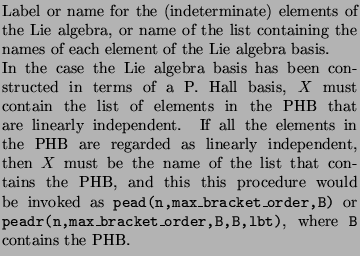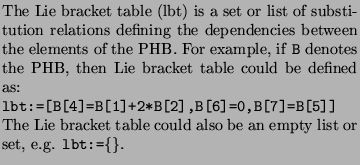



Next: wne, wner
Up: Function Reference
Previous: ead, eadr
Contents
Purpose
Compute the product of exponentials  . .
|
Syntax
e:=pead(n,max_bracket_order,X);
e:=peadr(n,max_bracket_order,X,B,lbt);
Description
Computes the product of exponentials  . .
peadr, reduces the Lie brackets in the expression
to elements in the PHB, and further simplifies the expression
according to the supplied Lie bracket table. If the Lie bracket table
is an empty list or set, no additional simplifications are carried
out.
|
Arguments


max_bracket_order



peadr additionally requires:




Examples
In this first example the computation of  is considered. Here is considered. Here  are Lie algebra
indeterminates, and the Taylor series expansion of the exponential are Lie algebra
indeterminates, and the Taylor series expansion of the exponential
 operator is computed up to brackets of order two. operator is computed up to brackets of order two.
> pead(2,2,x);
x[3] + g2 x[2] &* x[3] + 1/2 (g2 x[2] &* g2 x[2] &* x[3])
+ (g1 x[1] &* x[3]) + (g1 x[1] &* g2 x[2] &* x[3])
+ 1/2 (g1 x[1] &* (g2 x[2] &* g2 x[2] &* x[3]))
+ 1/2 (g1 x[1] &* (g1 x[1] &* x[3]))
+ 1/2 (g1 x[1] &* (g1 x[1] &* g2 x[2] &* x[3]))
+ 1/4 (g1 x[1] &* (g1 x[1] &* (g2 x[2] &* g2 x[2] &* x[3])))
For the next example consider the P. Hall basis B of the
example for the function phb on page ![[*]](file:/usr/share/latex2html/icons/crossref.png) .
The computation of .
The computation of  yields, yields,
> pead(2,2,B);
f2~ + (g2 f1~ &* f2~) + 1/2 (g2 f1~ &* (g2 f1~ &* f2~))
+ (g1 f0~ &* f2~) + (g1 f0~ &* (g2 f1~ &* f2~))
+ 1/2 (g1 f0~ &* (g2 f1~ &* (g2 f1~ &* f2~)))
+ 1/2 (g1 f0~ &* (g1 f0~ &* f2~))
+ 1/2 (g1 f0~ &* (g1 f0~ &* (g2 f1~ &* f2~)))
+ 1/4 (g1 f0~ &* (g1 f0~ &* (g2 f1~ &* (g2 f1~ &* f2~))))
Note that the above computation does not yields an expression whose
elements are in the P. Hall, if this additional simplification is
required then using peadr we obtain:
> peadr(2,2,B,B,{});
2
f2~ + g2 (f1~ &* f2~) + 1/2 g2 (f1~ &* (f1~ &* f2~))
2
+ g1 (f0~ &* f2~) + 1/2 g1 (f0~ &* (f0~ &* f2~))
|
|
Note that in the above example the degree of the highest order brackets is
three, unlike when pead was used, where the highest order
brackets are of degree five. This is due to the fact that
peadr calls reduceLBT to make simplifications, thus
brackets in the series expansion whose order is higher than
max_bracket_order are eliminated.
|
See Also




Next: wne, wner
Up: Function Reference
Previous: ead, eadr
Contents
Miguel Attilio Torres-Torriti
2004-05-31



